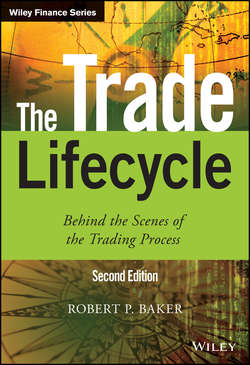Читать книгу The Trade Lifecycle - Baker Robert P. - Страница 32
На сайте Литреса книга снята с продажи.
Part One
Products and the Background to Trading
Chapter 3
Understanding Traded Products – Follow the Money
3.10 Credit default swap
ОглавлениеA credit default swap (CDS) is a contract between two parties referencing an entity or asset: a buyer of protection, also known as the seller of risk; and a seller of protection also called the buyer of risk.
A simple example would be:
JPMorgan buys protection from Banco Santander referencing Ford Motor Credit (Ford Motor Credit is the reference entity). The contract would have a specific term, say five years; an agreed notional amount, say USD 10m; a pre-agreed premium, typically called the ‘CDS spread’, say 800bp = 800 basis points = 8 % per annum – so the annual premium is approximately 10m × 800/10,000 = USD 800,000 per annum; an agreed list of ‘credit events’; and other details including payment method on a credit event.
A credit event triggers the termination of the contract and a capital payment. Typical credit events include bankruptcy, failure to pay, or restructuring of outstanding debt. In the context of credit derivatives, the term ‘default’ is often used to mean ‘credit event’ (in contrast, ‘default’ for bond assets typically only means failure to pay).
When a credit event occurs, the seller of protection pays either:
■ physical settlement: USD 10m in return for USD 10m notional of Ford Motor Credit debt; or
■ cash settlement: a net sum representing USD 10m less the value of Ford Motor Credit debt in the marketplace.
In summary, a CDS is an insurance policy. Generally the purchaser of insurance pays a sum of money at regular periods and these payments are known as premiums.
The seller (or writer) of a CDS will only pay out in the event of a default which is determined by a legally defined event or events. Once default has been triggered the whole trade ceases and no more premiums are paid. That is why only the first premium is shown as a solid line in Figure 3.14 because it is bound to occur, while the others are depicted as dotted lines.
Figure 3.14 Cashflows on CDS
The amount and time of payment are impossible to know at the start of the trade hence the striped rectangle of possible times and amounts. Here we are showing a CDS which pays in cash.
